NCERT Solutions for Class 6 Maths Exercise 10.3 book solutions are available in PDF format for free download. These ncert book chapter wise questions and answers are very helpful for CBSE exam. CBSE recommends NCERT books and most of the questions in CBSE exam are asked from NCERT text books. Class 6 Maths chapter wise NCERT solution for Maths Book all the chapters can be downloaded from our website and myCBSEguide mobile app for free.
NCERT solutions for Maths Mensuration Download as PDF

NCERT Solutions for Class 6 Maths Mensuration
Class –VI Mathematics
(Ex. 10.3)
Question 1.Find the areas of the rectangles whose sides are:
(a) 3 cm and 4 cm
(b) 12 m and 21 m
(c) 2 km and 3 km
(d) 2 m and 70 cm
Answer:
(a) Area of rectangle = length x breadth
= 3 cm x 4 cm = 12 cm2
(b) Area of rectangle = length x breadth
= 12 m x 21 m = 252 m2
(c) Area of rectangle = length x breadth
= 2 km x 3 km = 6 km2
(d) Area of rectangle = length x breadth
= 2 m x 70 cm = 2 m x 0.7 m = 1.4 m2
Question 2.Find the areas of the squares whose sides are:
(a) 10 cm
(b) 14 cm
(c) 5 cm
Answer:
(a) Area of square = side x side = 10 cm x 10 cm = 100 cm2
(b) Area of square = side x side = 14 cm x 14 cm = 196 cm2
(c) Area of square = side x side = 5 m x 5 m = 25 m2
Question 3.The length and the breadth of three rectangles are as given below:
(a) 9 m and 6 m
(b) 17 m and 3 m
(c) 4 m and 14 m
Which one has the largest area and which one has the smallest?
Answer:
(a) Area of rectangle = length x breadth = 9 m x 6 m = 54 m2
(b) Area of rectangle = length x breadth= 3 m x 17 m = 51 m2
(c) Area of rectangle = length x breadth= 4 m x 14 m = 56 m2
Thus, the rectangle (c) has largest area, i.e. 56 m2 and rectangle (b) has smallest area, i.e., 56 m2.
NCERT Solutions for Class 6 Maths Exercise 10.3
Question 4.The area of a rectangle garden 50 m long is 300 m2, find the width of the garden.
Answer:
Length of rectangle = 50 m and Area of rectangle = 300 m2
Since, Area of rectangle = length x breadth
Therefore, Breadth = {tex}\frac{{{\text{Area of rectangle}}}}{{{\text{Length}}}}{/tex} = = 6 m
Thus, the breadth of the garden is 6 m.
Question 5.What is the cost of tilling a rectangular plot of land 500 m long and 200 m wide at the rate of Rs. 8 per hundred sq. m?
Answer:
Length of land = 500 m and Breadth of land = 200 m
Area of land = length x breadth = 500 m x 200 m = 1,00,000 m2
{tex}\because {/tex} Cost of tilling 100 sq. m of land = Rs. 8
{tex}\therefore {/tex} Cost of tilling 1,00,000 sq. m of land = = Rs. 8000
NCERT Solutions for Class 6 Maths Exercise 10.3
Question 6.A table-top measures 2 m by 1 m 50 cm. What is its area in square meters?
Answer: Length of table = 2 m and breadth of table = 1 m 50 cm = 1.50 m
Area of table = length x breadth
= 2 m x 1.50 m = 3 m2
Question 7.A room us 4 m long and 3 m 50 cm wide. How many square meters of carpet is needed to cover the floor of the room?
Answer: Length of room = 4 m and breadth of room = 3 m 50 cm = 3.50 m
Area of carpet = length x breadth
= 4 x 3.50 = 14m2
NCERT Solutions for Class 6 Maths Exercise 10.3
Question 8.A floor is 5 m long and 4 m wide. A square carpet of sides 3 m is laid on the floor. Find the area of the floor that is not carpeted.
Answer: Length of floor = 5 m and breadth of floor = 4 m
Area of floor = length x breadth
= 5 m x 4 m = 20 m2
Now, Side of square carpet = 3 m
Area of square carpet = side x side = 3 x 3 = 9 m2
Area of floor that is not carpeted = 20 m2 – 9 m2 = 11 m2
Question 9.Five square flower beds each of sides 1 m are dug on a piece of land 5 m long and 4 m wide. What is the area of the remaining part of the land?
Answer: Side of square bed = 1 m
Area of square bed = side x side = 1 m x 1 m = 1 m2
{tex}\therefore {/tex} Area of 5 square beds = 1 x 5 = 5 m2
Now, Length of land = 5 m and breadth of land = 4 m
{tex}\therefore {/tex} Area of land = length x breadth = 5 m x 4 m = 20 m2
Area of remaining part = Area of land – Area of 5 flower beds
= 20 m2 – 5 m2 = 15 m2
NCERT Solutions for Class 6 Maths Exercise 10.3
Question 10.By splitting the following figures into rectangles, find their areas. (The measures are given in centimeters)
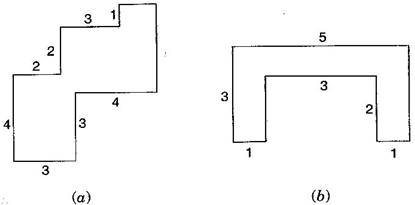
Answer:
(a) Area of HKLM = 3 x 3 = 9 cm2
Area of IJGH = 1 x 2 = 2 cm2
Area of FEDG = 3 x 3 = 9 cm2
Area of ABCD = 2 x 4 = 8 cm2
Total area of the figure = 9 + 2 + 9 + 8 = 28 cm2

(b) Area of ABCD = 3 x 1 = 3 cm2
Area of BDEF = 3 x 1 = 3 cm2
Area of FGHI = 3 x 1 = 3 cm2
Total area of the figure = 3 + 3 + 3 = 9 cm2
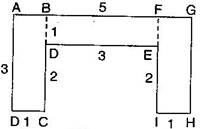
Question 11.Split the following shapes into rectangles and find their areas. (The measures are given in centimeters)
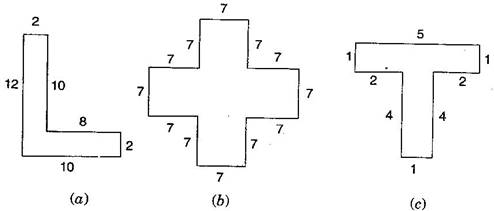
Answer:
(a) Area of rectangle ABCD = 2 x 10 = 20 cm2
Area of rectangle DEFG = 10 x 2 = 20 cm2
Total area of the figure = 20 + 20 = 40 cm2
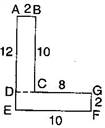
(b) There are 5 squares each of side 7 cm.
Area of one square = 7 x 7 = 49 cm2
Area of 5 squares = 49 x 5 = 245 cm2
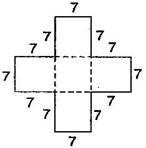
(c) Area of rectangle ABCD = 5 x 1 = 5 cm2
Area of rectangle EFGH = 4 x 1 = 4 cm2
Total area of the figure = 5 + 4 cm2

NCERT Solutions for Class 6 Maths Exercise 10.3
Question 12.How many tiles whose length and breadth are 12 cm and 5 cm respectively will be needed to fit in a rectangular region whose length and breadth are respectively:
(a)100 cm and 144 cm
(b)70 cm and 36 cm
Answer:
(a) Area of region = 100 cm x 144 cm = 14400 cm2
Area of one tile = 5 cm x 12 cm = 60 cm2
Number of tiles = {tex}\frac{{{\text{Area of region}}}}{{{\text{Area of one tile}}}}{/tex}
= 240
Thus, 240 tiles are required.
(b) Area of region = 70 cm x 36 cm = 2520 cm2
Area of one tile = 5 cm x 12 cm = 60 cm2
Number of tiles = {tex}\frac{{{\text{Area of region}}}}{{{\text{Area of one tile}}}}{/tex}
= 42
Thus, 42 tiles are required.
NCERT Solutions for Class 6 Maths Exercise 10.3
NCERT Solutions Class 6 Maths PDF (Download) Free from myCBSEguide app and myCBSEguide website. Ncert solution class 6 Maths includes text book solutions from Class 6 Maths Book . NCERT Solutions for CBSE Class 6 Maths have total 14 chapters. 6 Maths NCERT Solutions in PDF for free Download on our website. Ncert Maths class 6 solutions PDF and Maths ncert class 6 PDF solutions with latest modifications and as per the latest CBSE syllabus are only available in myCBSEguide.
NCERT Solutions for Mathematics Class 3rd to 12th
- NCERT Solutions for Class 12 Mathematics
- NCERT Solutions for Class 11 Mathematics
- NCERT Solutions for Class 10 Mathematics
- NCERT Solutions for Class 9 Mathematics
- NCERT Solutions for Class 8 Mathematics
- NCERT Solutions for Class 7 Mathematics
- NCERT Solutions for Class 6 Mathematics
- NCERT Solutions for Class 5 Mathematics
- NCERT Solutions for Class 4 Mathematics
- NCERT Solutions for Class 3 Mathematics
CBSE app for Students
To download NCERT Solutions for Class 6 Maths, Social Science Computer Science, Home Science, Hindi English, Maths Science do check myCBSEguide app or website. myCBSEguide provides sample papers with solution, test papers for chapter-wise practice, NCERT solutions, NCERT Exemplar solutions, quick revision notes for ready reference, CBSE guess papers and CBSE important question papers. Sample Paper all are made available through the best app for CBSE students and myCBSEguide website.

Test Generator
Create question paper PDF and online tests with your own name & logo in minutes.
Create Now
Learn8 App
Practice unlimited questions for Entrance tests & government job exams at ₹99 only
Install Now